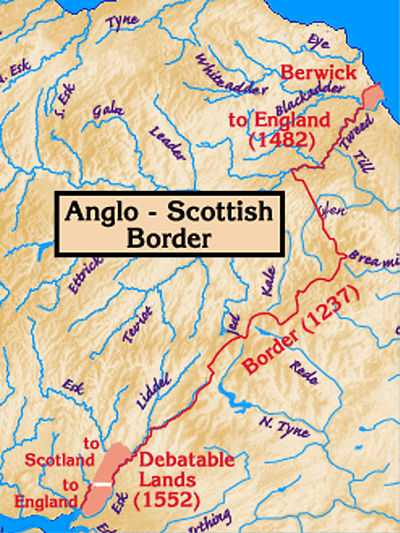Debatable Lands

The Debatable Lands, also known as debatable ground, batable ground or thriep lands,[1] was land lying between Scotland and England, formerly in question to which it belonged, when they were distinct kingdoms. The name signifies the same thing as litigious or disputable ground.[2]
History
The Debatable Lands extended from the Solway Firth near Carlisle to Langholm in Dumfries and Galloway, the largest population centre being Canonbie. The lands included the baronies of Kirkandrews, Bryntallone and Morton.[1] They were around ten miles (16 km) long from north to south and four miles (6 km) wide. The boundaries were marked by the rivers Liddel and Esk in the east and the River Sark in the west. For over three hundred years they were effectively controlled by local clans, such as the Armstrongs, who successfully resisted any attempt by the Scottish or English governments to impose their authority. In his history of the Border Reivers (The Steel Bonnets (1971)), George Macdonald Fraser says that the Armstrongs alone could put 3,000 men in the field. They launched frequent raids on farms and settlements outside the Debatable Lands, the profits enabling them to become major landowners. Other clans in the area were the Elwands, Ellwoods, or Elliots who extended into Teviotdale; the Nixons who were more numerous in Cumberland; the Crossars in Upper Liddesdale, with their chief stronghold in Riccarton; and the Grahams, who owned five towers in the Debatable Land. The Irvings, Olivers, Bells, Dicksons, and Littles were also present in varying numbers.[1]
In 1530, King James V took action against the lawless clans of the Debatable Lands and imprisoned the Lords Bothwell, Maxwell and Home, Walter Scott of Buccleuch, and other border lairds for their lack of action. James took various other steps, but significantly he broke the strength of the Armstrongs by hanging Johnnie Armstrong of Gilnockie and thirty-one others at Carlanrig Chapel, under questionable circumstances.[3]
In 1551 the Crown officers of England and Wales, in an attempt to clear out the trouble makers, declared that "All Englishmen and Scottishmen, after this proclamation made, are and shall be free to rob, burn, spoil, slay, murder and destroy all and every such persons, their bodies, buildings, goods and cattle as do remain or shall inhabit upon any part of the said Debatable Land without any redress to be made for the same."
In 1552 a border line was agreed by commissioners, and soon after the Scots' Dike was built to mark the line; this did not, however, stop the lawlessness.
When the thrones of Scotland and England were united in 1603, King James VI of Scotland also became James I of England, and he embarked on the so-called "Pacification of the Borders", purging the Border reivers, destroying their fortified tower houses, rounding up their families and sending them to Ireland and elsewhere.
See also
- List of places in the Scottish Borders
- Anglo-Scottish border
- Berwick-upon-Tweed
- Scottish Marches
- Scots' Dike
Notes
- ↑ 1.0 1.1 1.2 Maxwell 1897, p. 161.
- ↑ Chambers 1728, p. 91.
- ↑ Maxwell 1897, pp. 161–167.
References
- Maxwell, Sir Herbert (1897). A History of Dumfries and Galloway. Edinburgh: William Blackwood and Sons. pp. 161–167.
- Attribution
 This article incorporates text from a publication now in the public domain: Chambers, Ephraim, ed. (1728). "batable ground". Cyclopædia, or an Universal Dictionary of Arts and Sciences 1 (first ed.). James and John Knapton, et al. p. 91.
This article incorporates text from a publication now in the public domain: Chambers, Ephraim, ed. (1728). "batable ground". Cyclopædia, or an Universal Dictionary of Arts and Sciences 1 (first ed.). James and John Knapton, et al. p. 91.
Further reading
- Robson, Eric (2006). The Border Line. Frances Lincoln Ltd.
- Mack, James Logan (1926). The Border Line. Oliver & Boyd.
- "Romanticism’s Debatable Lands". The British Association for Romantic Studies, Biennial Conference (University of Newcastle upon Tyne). 28–31 July 2005.
- "Debatable Lands". Border Reivers Website.
- BBC staff. "A village on debatable land... The small village of Bewcastle". BBC.
- "A Researcher's Guide to Local History terminology".